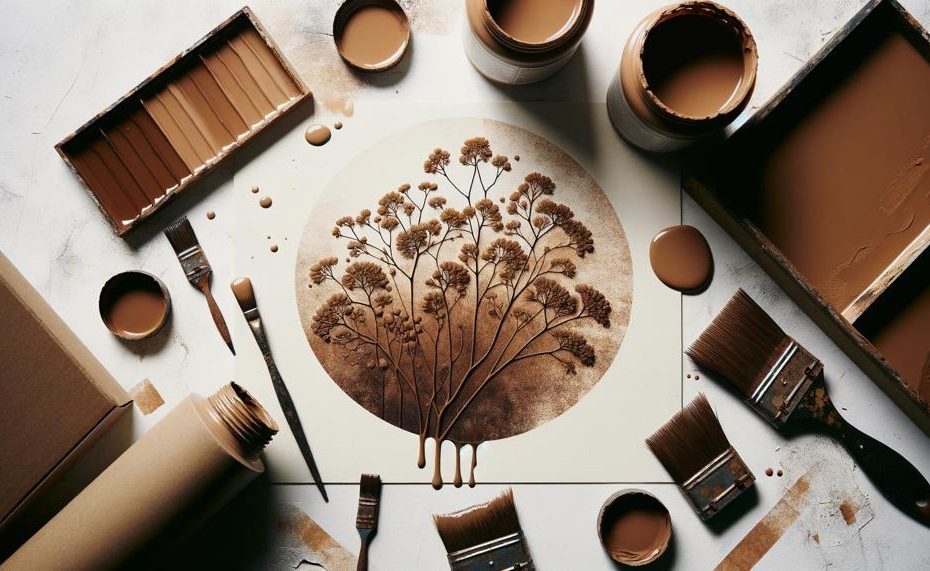Ever encountered the perplexing sight of brown stains creeping through your freshly primed walls?
It’s like a scene from a mystery novel, but it happens more often than you’d think. In our latest post, we’ll unravel the enigma of these stubborn marks that defy even the best primer.

We’ll explore common culprits, such as moisture issues or underlying stains, and how they can resurface to haunt your paint job. Plus, we’ll provide practical tips for preventing and tackling this pesky problem, ensuring your walls stay pristine.
So, Why is brown stain coming through primer?
Brown stains appearing through primer can be frustrating, especially when you’re aiming for a flawless paint job. Let’s explore the reasons behind this phenomenon and how to address it:
- Tannins in Wood: The primary culprit is often the presence of tannins in the wood. These natural compounds can bleed through the primer and become more noticeable when you apply lighter paint colors. Tannins are particularly common in certain types of wood, such as pine and cedar.
- Oil-Based Paint Residue: When using oil-based paint, solvents may evaporate and leave behind an oily residue on the surface. This residue can contribute to brown stains. Similarly, the binder in the paint can cause stains if there are too many solids in the pigment.
- Insufficient Paint Coverage: Brown stains often appear on walls and ceilings due to an insufficient amount of paint being applied. If you don’t use enough paint, it takes longer to dry, allowing more moisture to seep through before it fully sets. This increased moisture can lead to those pesky brown stains.
So, let’s get started.
Contents [show]
Best Primer
In addressing brown stains in home improvement projects, the optimal approach is to apply a stain-blocking primer, specifically one that is shellac-based.
The crux of success lies in the type of primer used, as not all primers offer the same level of effectiveness against stubborn stains such as those caused by tannins in wood.
Top Recommended Primers:
| Primer | Type | Key Features |
| Zinsser B-I-N | Shellac-based | Exceptional for blocking tannin; quick-drying |
| KILZ Restoration | Water-based | Handles moderate stains; low odor |
| Rust-Oleum Zinsser Cover Stain | Oil-based | Excellent for severe stains; high adhesion |
In practice, when tackling a wood surface that’s prone to tannin bleeding, applying a primer like Zinsser B-I-N is a reliable approach. For less severe stains, a product like KILZ Restoration can be effective, offering a balance between performance and ease of use.
However, in the face of heavy stains or water damage, Rust-Oleum Zinsser Cover Stain, being oil-based, provides robust coverage.
It’s pivotal to remember that applying a second coat and allowing adequate drying time are key factors in ensuring the success of these products.
Steps To Fix Brown Stain Coming Through Primer
To tackle the stubborn brown stain peeking through primer on your wall or surface, here’s a step-by-step guide.
This approach ensures your wall is pristine, showcasing the importance of patience and precision in DIY projects.
Identify the Culprit
First off, it’s vital to recognize what’s causing the brown stain. Tannins from wood are often the culprits, especially with lighter paint hues. Understanding the source is crucial for a targeted fix.
Prime Solution
A second coat of primer is your best solution for covering those pesky brown stains. Opt for a shellac-based or stain-blocking primer to keep those tannins in check.
| Step | Action | Tip |
| 1 | Clean the surface | Ensure the wall is free of dust and grease for optimal primer adhesion. |
| 2 | Apply the first coat of primer | Use a high-quality brush or roller for even coverage. |
| 3 | Let it dry thoroughly | Patience is key. Allow it to dry for a full day. |
| 4 | Apply a second coat of primer | Focus on areas with visible stains. |
| 5 | Test and repeat if necessary | If stains persist, consider a third coat. |
Topcoat Tactics
After priming, it’s time for the topcoat. Sometimes, a single layer won’t do. Here’s how to ensure those stains stay hidden:
- Apply the first coat of paint: Choose a paint that complements your primer for best results.
- Dry and observe: Let the first coat dry entirely, then check for stain bleed-through.
- Second coat: If needed, apply a second coat to completely mask the stain.
Take Your Time
Rushing can lead to disappointment with stains reappearing. Each layer needs to dry fully before the next step. It’s not just about covering up; it’s about ensuring a lasting, flawless finish.
Conclusion
It can be frustrating and mysterious to find dark spots on your walls that are seeping through the primer. But this common problem with home improvements is not impossible to fix. Mastering these stubborn marks means knowing where they came from and using the right method to keep your walls clean.
After you prime your walls, moisture problems and spots that were there before, especially from tannins in wood, will often come back to haunt you. What’s the cure? Use the right kind of primer with great care. People love shellac-based stain-blocking bases like Zinsser B-I-N because they are so good at keeping these blemishes from showing through, leaving a clean surface for your paint job. When the damage isn’t too bad, water-based products like KILZ Restoration work well and are easy to use. On the other hand, oil-based products like Rust-Oleum Zinsser Cover Stain are the best defense against tougher stains and water damage.
But to beat these stubborn enemies, you need more than just the right ammo. You also need to be patient and accurate. Important steps include applying a second coat, letting it dry completely, and using finish techniques like checking for flaws and possibly adding more coats.





